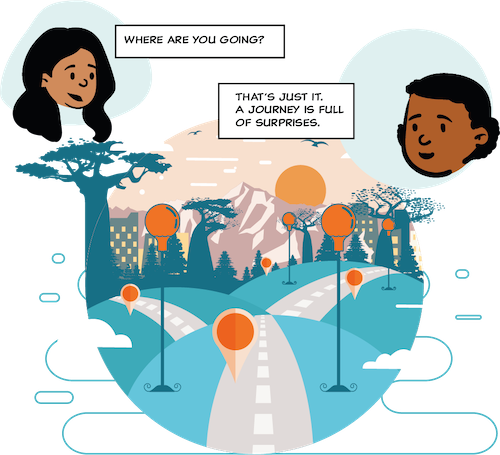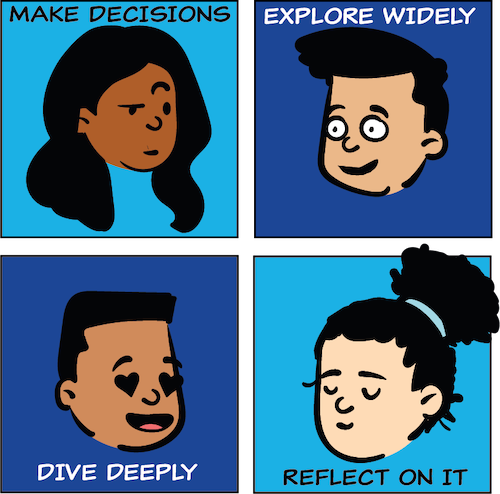
What is a Learning Journey?
A journey is a way of exploring the world. It is different than following a predetermined path or finding the shortest route to a destination. A journey is open to unexpected discoveries and adventures. A journey is heading out into the unknown.
A journey is not about reaching a destination; it is about the experience.
A Learning Journey is a metaphor to help you understand that learning isn’t about memorizing facts and regurgitating them on a test. A Learning Journey is a process of seeing what is out in the world and discovering your strengths. Going on a Learning Journey is the method you will use to explore the world and find your place in it.
One type of journey is to have no plans and no strategies. To just head out into the unknown and see what happens.
Sometimes that works out fine. If that describes you, go ahead and close this field guide and head out into the wilderness.
Go for it.
If you are still reading this, you probably realize that it might help to have a little bit of a strategy. Maybe pack a few things, first.
The rest of this book is about the tools and strategies to help you navigate the wilderness. It is your Field Guide to your Learning Journey.
Remember the overall purpose is to live a good life.
Also remember that a good life can look very different for different people but there are four qualities that we will focus on. These four qualities, autonomy, competence, confidence, and connection give us hint at a way to start living a good life.
The way we are going to work on your autonomy, develop your competence, build your confidence, and make your connections is to go on a Learning Journey.
In this way, a Learning Journey is what you do for "school" but it is a little bit different than what most people think of as school.
For one, there isn't a place where you go for all of your learning. Instead, it recognizes that you can learn in all kinds of different settings. You can learn on your own or with a friend. You can learn online or in a classroom. You can create your own projects and follow your own research or you can work with a teacher. You can learn at home or on a campus.
Instead of placing all of the resources in a single school building, a Learning Journey says, there isn't a building at all. The resources are all over the world. On your Learning Journey you can pull together learning opportunities from anywhere and craft a path that makes sense for you.
On one hand, what a great opportunity. You can learn anything, anywhere.
On the other hand, wait a minute ... the whole world is pretty big, there are a lot of options to pick from, how do you know what to pick?
Here is where the tools and strategies come in.

Four Key Strategies for Your Learning Journey
To help you on your Learning Journey, there are four key strategies you should concentrate on.
- Make Decisions
- Explore Widely
- Dive Deeply
- Reflect on It
In section two we will get into greater detail about each of these four strategies but for now, let’s make sure you understand the big picture.
The first strategy is Make Decisions.
Making decisions is about understanding and accepting that you are in charge of your Learning Journey. It is all about making choices for yourself, listening to your curiosity, following your interests, setting your own goals, telling your own story.
On your Learning Journey you are free to pick where you learn. Perhaps you want to take a class at a traditional school but you also want to learn by working in your community. You are free to pick the places where you learn.
You are also free to pick what you learn. Maybe you want to learn about chemistry but you also love old movies and you love to draw. You get to decide what has meaning in your life.
You are in charge. That is a big responsibility. It might seem scary or even intimidating to be in charge of your Learning Journey.
Don’t worry. You are worthy of it. You are a human being with agency. You deserve to make decisions about your own life.
Yes, you might take some missteps. You are going to change your mind along the way. That is a part of the process. Mistakes are opportunities to learn. Journeys have wrong turns.
Don’t worry. You don’t have to do it by yourself. You aren’t being sent into the wilderness alone, without a compass. You should surround yourself with people who will help you navigate your Learning Journey; family, friends, peers, guides, teachers, advisors, mentors, experts, partners. Learning is a team sport. You are in charge but you should have a team supporting you.
That brings us to key strategy number two, Explore Widely.
It’s a big world with a lot to see and experience. This is your chance to see what is out there. You live in a time and place where an unbelievable amount of information is available to you online, in books, movies, audio. For thousands of years people who came before you left behind stories, ideas, discoveries, inventions, and advice.
Part of exploring widely is sampling some of what came before you. Dip your toes into the stream of human experiences. See what other people have figured out. Listen to their stories. Join in the conversation that goes back thousands of years.
On the other hand, part of exploring widely is also having your own experiences; make things, create, meet people, be out in nature, work, volunteer, and engage with the outside world.
Try out different ways to learn; take classes, get a job, travel, do projects, find a mentor, join clubs, play games, read.
Learn about new things; explore new ideas, find out about the past, think about the future, work on new skills and talents, develop new habits.
Learn by yourself, learn with new people, learn from new people. Teach and mentor people.
Some of the ideas you come across or the experiences you have will speak to you more than others. Some parts of your Learning Journey will tap into your particular strengths and interests. Some ideas will draw you deeper. There will be skills that you want to develop because they will help you reach your goals. There will be habits that you find helpful and you decide to actively pursue them.
This is what is meant by key strategy number three, Dive Deeply.
Diving deeply during your Learning Journey is when you are applying your individual strengths and skills towards your goals. You are seeing places where you might fit in. You are discovering what brings meaning and purpose to your life. You might have interests and decide to follow them deeply. You might work on the skills and habits that will help you reach your goals.
When you dive deeply you are having the experiences that will prepare you for your next steps. You will work on the habits and mindsets that help you live a good life.
The final key strategy, Reflect on it, is taking the time to think about what is happening. All too often we go through life on autopilot. To make your Learning Journey truly an effective process of living a good life it will be important to reflect on your decisions; consider whether you are Exploring Widely, plan your Deep Dives, capture how much progress you have made, and imagine what to do next.
Reflecting is a way of taking stock of your Learning Journey. It will help you recognize when you need to make adjustments or seek out help. Reflecting will allow you to listen closely to your heart and find the places that fill your life with meaning. It will also help you understand yourself, help you identify your strengths, and help you integrate everything that is happening into a story about your adventures.
Ok, so you are going on a Learning Journey to help you live a good life.

How does a Learning Journey work?
Let’s talk details. How does a Learning Journey work?
There isn’t a map. There isn’t an itinerary. There is no predetermined path to follow.
A Learning Journey is very open ended. At the beginning you might not know everything you are going to see and do but that is kind of the point of a journey.
Instead of having a path to follow, you are going to make all of the decisions about what to learn and how best to learn as you go. To help make those decisions you will use the four key strategies.
- Make Decisions
- Explore Widely
- Dive Deeply
- Reflect on it
That’s it. A Learning Journey isn’t about learning specific content or passing standardized tests or passing a set of required classes. It is about following these strategies.
Going on a Learning Journey is a process. It is a process for living a good life. And following these strategies will help you make progress towards the qualities that are associated with a good life; Autonomy, Competence, Confidence, and Connection.
This is quite a bit different from the way we typically think about school.
It is all about the process. Think about the phrase, “get an education.” It implies that learning is something that you can acquire, maybe like you could acquire a car. When you acquire a car you go to a car dealership, pick out a car, pay for it, and drive it off the lot.
In some ways, we think of traditional school in a similar way. You go to a building, you do the things they tell you to do, they give you a diploma, and you walk away with “an education.”
Going on a Learning Journey is something different. It is about the process, the experience, the journey.
The goal isn’t to walk away with a piece of paper that says you graduated. The goal is to live a good life. You are going to use the Learning Journey to accomplish that goal.
Understanding the four strategies will help you navigate your Learning Journey.
Don’t worry. You are still completely in charge. These strategies don’t limit what you learn, determine who you learn with, dictate how you learn, and most importantly don’t tell you why something is important.
Those are all decisions for you to make.
In fact, decision making is the heart of strategy number one.
Summary
What is a Learning Journey?
A Learning Journey is an approach to schooling where you are in charge of making decisions about who you learn with, what kind of things are important to learn, when is the best time and best pace to learn something, where is the best place for you to learn, why something might be important for you, and how is the best way for you to learn.


